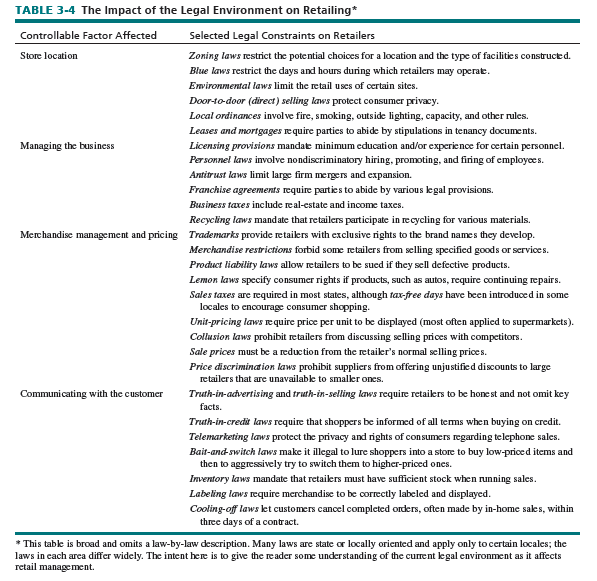1. SPECIFIC ACTIVITIES
Short-run decisions are now made and enacted for each controllable part of the strategy in Figure 3-9. These actions are known as tactics and encompass a retailer’s daily and short-term operations. They must be responsive to the uncontrollable environment. Here are some tactical moves a retailer may make:
- Store location. Trading-area analysis gauges the area from which a firm draws its customers. The level of competition in a trading area is studied regularly. Relationships with nearby retailers are optimized. A chain carefully decides on the sites of new outlets. Facilities are actually built or modified.
- Managing the business. There is a clear chain of command from managers to workers. An organization structure is set into place. Personnel are hired, trained, and supervised. Financial management tracks assets and liabilities. The budget is spent properly. Operations are system- ized and adjusted as required.
- Merchandise management and pricing. Assortments in departments and the space allotted to each department require constant decisions. Innovative firms look for new merchandise and clear out slow-moving items. Purchase terms are negotiated and suppliers sought. Selling prices reflect the firm’s image and target market. Price ranges offer consumers some choice. Adaptation is needed to respond to higher supplier prices and react to competitors’ prices.
- Communicating with the customer. The storefront and display windows, store layout, and merchandise displays need regular attention. These elements help gain consumer enthusiasm, present a fresh look, introduce new products, and reflect changing seasons. Ads are placed during the proper time and in the proper media. The deployment of sales personnel varies by merchandise category and season.

The essence of retailing excellence is building a sound strategy and fine-tuning it. A firm that stands still is often moving backward. Tactical decision making is discussed in detail in Chapters 9 through 19.
2. CONTROL
In the control phase of strategic planning for retailers, a review takes place (Step VI in Figure 3-1), as the strategy and tactics (Steps IV and V) are assessed against the business mission, objectives, and target market (Steps I, II, and III). This procedure is called a retail audit, which is a systematic process for analyzing the performance of a retailer. The retail audit is covered in Chapter 20.
The strengths and weaknesses of a retailer are revealed as performance is reviewed. The aspects of a strategy that have gone well are maintained; those that have gone poorly are revised, consistent with the mission, goals, and target market. The adjustments are reviewed in the firm’s next retail audit.
3. FEEDBACK
At each strategic stage, an observant management receives signals or cues, known as feedback, as to the success or failure of that part of the strategy. Again, refer to Figure 3-1. Positive feedback includes high revenue, a high percentage of customers renewing annual membership in a membership (warehouse) club, and low employee turnover and absenteeism. Negative feedback includes falling sales revenue, low membership renewals, and high employee turnover and absenteeism. Retail executives look for positive and negative feedback so they can determine the causes and then capitalize on opportunities or rectify problems.
Source: Barry Berman, Joel R Evans, Patrali Chatterjee (2017), Retail Management: A Strategic Approach, Pearson; 13th edition.

There is noticeably a bundle to identify about this. I consider you made various good points in features also.
Hi, Neat post. There’s a problem with your site in web explorer, could check thisK IE nonetheless is the marketplace leader and a huge component to other folks will omit your excellent writing due to this problem.